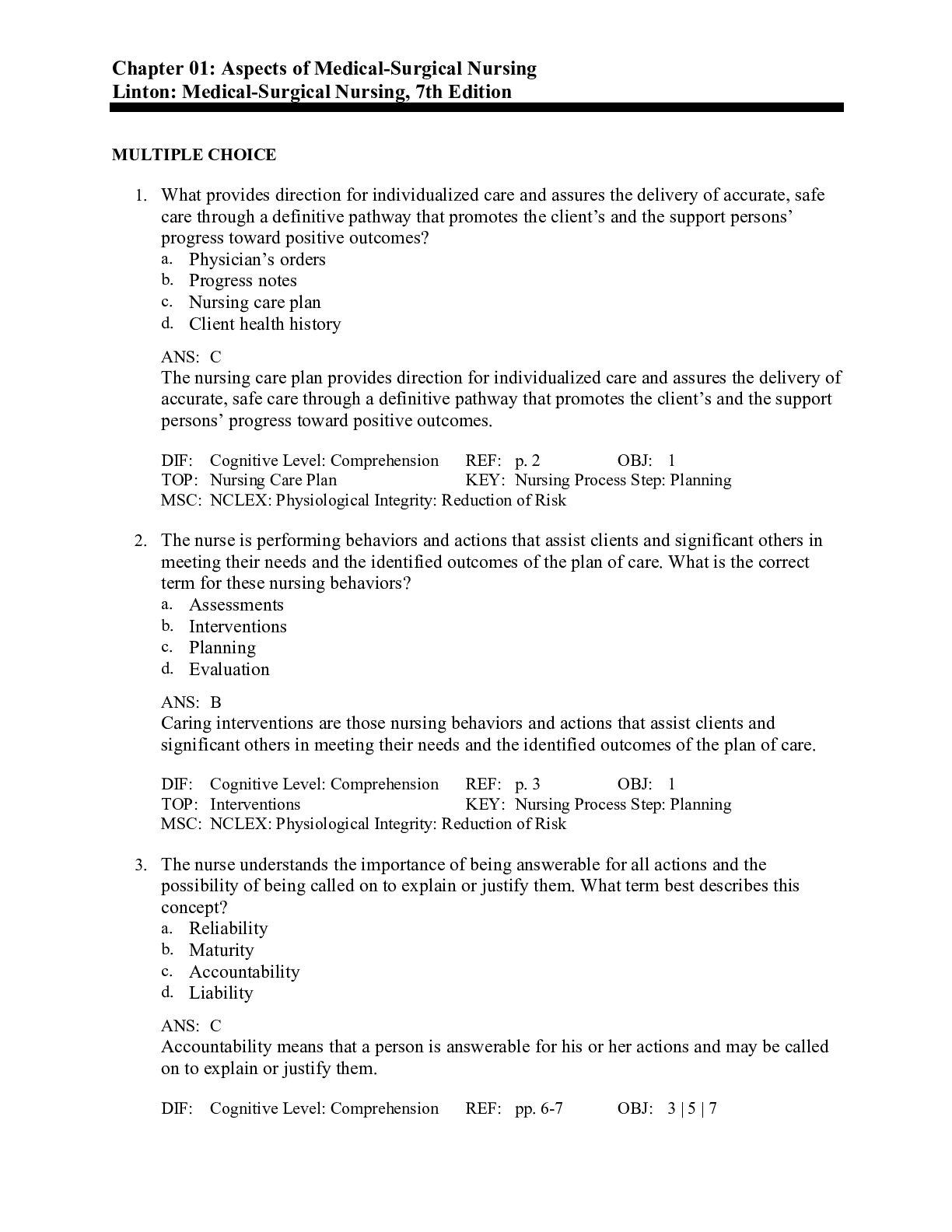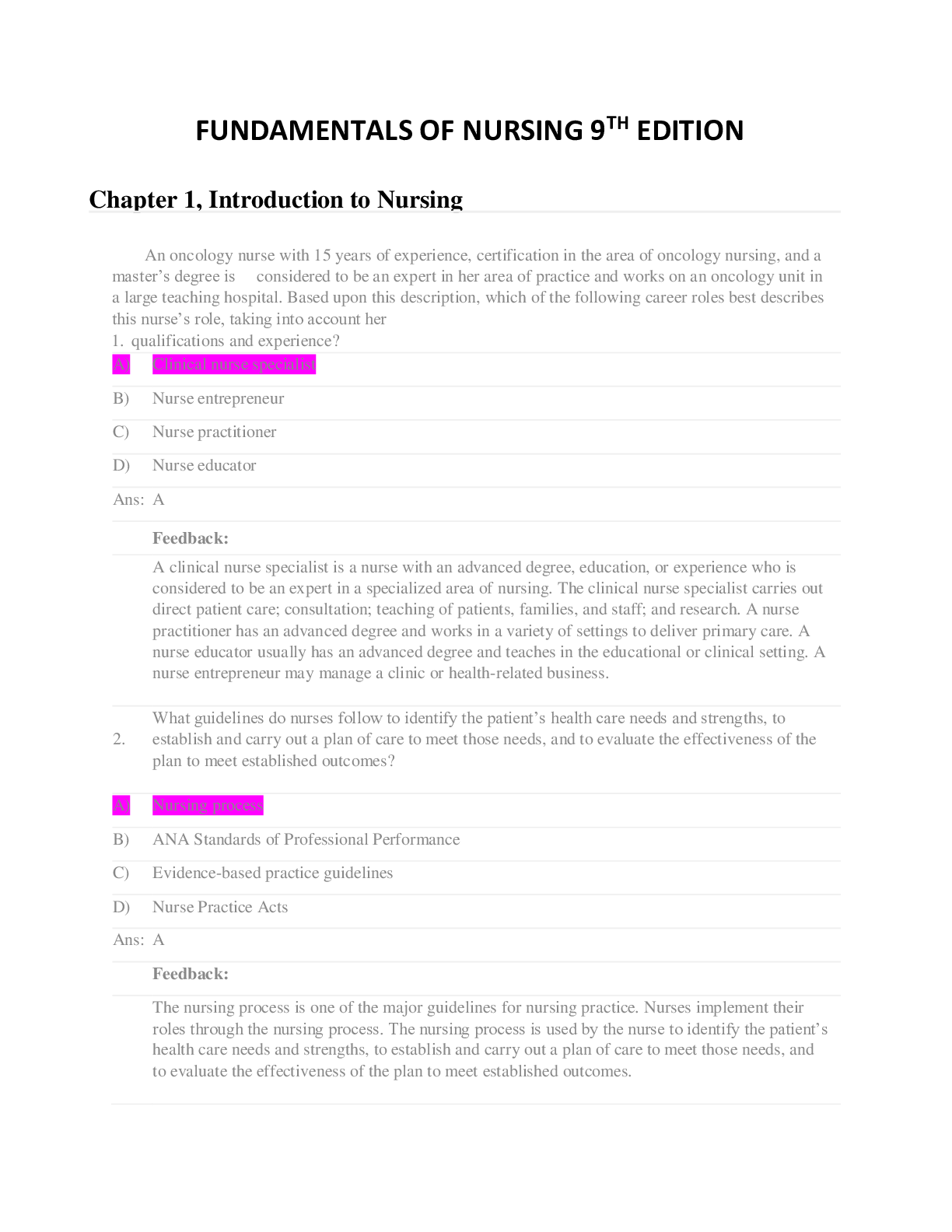Biology > TEST BANKS > BIO 211 Test Bank for Fundamentals of Nursing, 9e 9th Edition (All)
BIO 211 Test Bank for Fundamentals of Nursing, 9e 9th Edition
Document Content and Description Below
Chapter 02: The Health Care Delivery System Potter et al.: Fundamentals of Nursing, 9th Edition MULTIPLE CHOICE 1. The nurse is caring for a patient whose insurance coverage is Medicare. The nurse ... should consider which information when planning care for this patient? a. Capitation provides the hospital with a means of recovering variable charges. b. The hospital will be paid for the full cost of the patient’s hospitalization. c. Diagnosis-related groups (DRGs) provide a fixed reimbursement of cost. d. Medicare will pay the national average for the patient’s condition. ANS: C In 1983, Congress established the prospective payment system (PPS), which grouped inpatient hospital services for Medicare patients into diagnosis-related groups (DRGs), each of which provides a fixed reimbursement amount based on assigned DRG, regardless of a patient’s length of stay or use of services. Capitation means that providers receive a fixed amount per patient or enrollee of a health care plan. DRG reimbursement is based on case severity, rural/urban/regional costs, and teaching costs, not national averages. DIF:Understand (comprehension)REF:15 OBJ: Compare the various methods for financing health care. TOP: Planning MSC:Management of Care 2. A nurse is teaching the staff about managed care. Which information should the nurse include in the teaching session? a. Managed care insures full coverage of health care costs. b. Managed care only assumes the financial risk involved. c. Managed care allows providers to focus on illness care. d. Managed care causes providers to focus on prevention. ANS: D Managed care describes health care systems in which the provider or the health care system receives a predetermined capitated (fixed amount) payment for each patient enrolled in the program. Therefore, the focus of care shifts from individual illness care to prevention, early intervention, and outpatient care. The actual cost of care is the responsibility of the provider. The managed care organization (provider) assumes financial risk, in addition to providing patient care. DIF:Understand (comprehension)REF:15 OBJ: Explain the structure of the United States health system. TOP: Teaching/Learning MSC:Management of Care 3. A nurse is teaching a family about health care plans. Which information from the nurse indicates a correct understanding of the Affordable Care Act? a. A family can choose whether to have health insurance with no consequences. b. Primary care physician payments from Medicaid services can equal Medicare. c. Adult children up to age 26 are allowed coverage on the parent’s plan. d. Private insurance companies can deny coverage for any reason. ANS: C Adult children up to the age of 26, regardless of student status, are allowed to be covered under their parents’ health insurance plan. All individuals are required to have some form of health insurance by 2014 or pay a penalty through the tax code. Primary care physician payments for Medicaid services increased to equal Medicare payments. Implementation of insurance regulations prevents private insurance companies from denying insurance coverage for any reason and from charging higher premiums based on health status and gender. DIF:Remember (knowledge)REF:15-16 OBJ: Explain the structure of the United States health system. TOP: Teaching/Learning MSC:Management of Care 4. A nurse is caring for a patient in the hospital. When should the nurse begin discharge planning? a. When the patient is ready b. Close to the time of discharge c. Upon admission to the hospital d. After an order is written/prescribed ANS: C Discharge planning begins the moment a patient is admitted to a health care facility. When the patient is ready may be too late. Close to the time of discharge and after an order is written/prescribed are too late. DIF:Remember (knowledge)REF:19 OBJ: Discuss the role of nurses in different health care delivery settings. TOP lanningMSC:Management of Care 5. The nurse is applying for a position with a home care organization that specializes in spinal cord injury. In which type of health care facility does the nurse want to work? a. Secondary acute b. Continuing c. Restorative d. Tertiary ANS: C Patients recovering from an acute or chronic illness or disability often require additional services (restorative care) to return to their previous level of function or reach a new level of function limited by their illness or disability. Restorative care includes cardiovascular and pulmonary rehabilitation, sports medicine, spinal cord injury programs, and home [Show More]
Last updated: 2 years ago
Preview 1 out of 14 pages
 (1).png)
Buy this document to get the full access instantly
Instant Download Access after purchase
Buy NowInstant download
We Accept:

Reviews( 0 )
$7.00
Can't find what you want? Try our AI powered Search
Document information
Connected school, study & course
About the document
Uploaded On
Jul 29, 2022
Number of pages
14
Written in
Additional information
This document has been written for:
Uploaded
Jul 29, 2022
Downloads
0
Views
87

.png)




 (1).png)

 (1).png)















